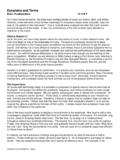Transcription of SOLID MECHANICS DYNAMICS TUTORIAL …
1 1 SOLID MECHANICS DYNAMICS TUTORIAL moment OF inertia This work covers elements of the following syllabi. Parts of the Engineering Council Graduate Diploma Exam D225 DYNAMICS of Mechanical Systems Parts of the Engineering Council Certificate Exam C105 Mechanical and Structural Engineering. Part of the Engineering Council Certificate Exam C103 - Engineering Science. On completion of this TUTORIAL you should be able to Revise angular motion. Define and derive the moment of inertia of a body. Define radius of gyration. Examine Newton s second law in relation to rotating bodies. Define and use inertia torque. Define and use angular kinetic energy. Solve problems involving conversion of potential energy into kinetic energy.
2 It is assumed that the student is already familiar with the following concepts. Newton s Laws of Motion. The laws relating angular displacement, velocity and acceleration. The laws relating angular and linear motion. The forms of mechanical energy. All the above may be found in the pre-requisite tutorials. 2 1. REVISION OF ANGULAR QUANTITIES Angular motion is covered in the pre-requisite TUTORIAL . The following is a summary needed for this TUTORIAL . ANGLE Angle may be measured in revolutions, degrees, grads (used in France) or radians. In engineering we normally use radians. The links between them are 1 revolution = 360o = 400 grads = 2 radian ANGULAR VELOCITY Angular velocity is the rate of change of angle with time and may be expressed in calculus terms as the differential coefficient dtd ANGULAR ACCELERATION Angular acceleration is the rate of change of angular velocity with time and in calculus terms may be expressed by the differential coefficient dtd or the second differential coefficient 22dt d LINK BETWEEN LINEAR AND ANGULAR QUANTITIES.
3 Any angular quantity multiplied by the radius of the rotation is converted into the equivalent linear quantity as measured long the circular path. Hence angle is converted into the length of an arc by x = R Angular velocity is converted into tangential velocity by v = R Angular acceleration is converted into tangential acceleration by a = R TORQUE When we rotate a wheel, we must apply torque to overcome the inertia and speed it up or slow it down. You should know that torque is a moment of force. A force applied to the axle of a wheel will not make it rotate (figure 1A). A force applied at a radius will (figure 1B). The torque is F r (N m). Figure 1 A Figure 1 B 3 2.
4 moment OF inertia I The moment of inertia is that property of a body which makes it reluctant to speed up or slow down in a rotational manner. Clearly it is linked with mass ( inertia ) and in fact moment of inertia means second moment of mass. It is not only the mass that governs this reluctance but also the location of the mass. You should appreciate that a wheel with all the mass near the axle (fig. 2A) is easier to speed up than one with an equal mass spread over a larger diameter ( ). Figure 2A Figure 2 B DERIVATION Consider the case where all the mass is rotating at one radius. This might be a small ball or a rim (like a bicycle wheel) as shown with mass m at radius r. The angular velocity is rad/s.
5 Figure 3 If we multiply the mass by the radius we get the first moment of mass r m If we multiply by the radius again we get the second moment of mass r2 m This second moment is commonly called the moment of inertia and has a symbol I. Unfortunately most rotating bodies do not have the mass concentrated at one radius and the moment of inertia is not calculated as easily as this. RADIUS OF GYRATION k All rotating machinery such as pumps, engines and turbines have a moment of inertia . The radius of gyration is the radius at which we consider the mass to rotate such that the moment of inertia is given by I = M k2 M is the total mass and k is the radius of gyration. The only problem with this approach is that the radius of gyration must be known and often this is deduced from tests on the machine.
6 4 PLAIN DISC Consider a plain disc and suppose it to be made up from many concentric rings or cylinders. Each cylinder is so thin that it may be considered as being at one radius r and the radial thickness is a tiny part of the radius r. These are called elementary rings or cylinders. If the mass of one ring is a small part of the total we denote it m. The moment of inertia is a small part of the total and we denote it I and this is given by I = r2 m. The total moment of inertia is the sum of all the separate small parts so we can write I = I = r2 m The disc is b metres deep. Establish the formula for the mass of one ring. Figure 4 The elementary thin cylinder if cut and unrolled would form a flat sheet as shown.
7 Length = circumference = 2 r depth depth = b thickness = r Volume = length x depth x thickness = 2 r b r Change this to mass m by multiplying by the density of the material . Mass = m= b 2 r r If the mass is multiplied by the radius twice we get the moment of inertia I. I = b 2 r r2 r = b 2 r3 r As the radial thickness r gets thinner and tends to zero, the equation becomes precise and we may replace the finite dimensions with the differential d. d I = b 2 r3 dr The total moment of inertia is found by integration which is a way of summing all the rings that make up the disc. Ro3Ro3drr 2 Ihave sign we integral theoutside constants the takingand drr b 2 I b 5 Completing the integration and substituting the limits of r = 0 (the middle) and r = R (the outer radius) we get the following.
8 2R bI40R b 2 4rb 2 drr b 2 I444R04R03 Now consider the volume and mass of the disc. The volume of the plain disc is the area of a circle radius R times the depth b. Volume = R2b Mass = volume x density = R2b Examine the formula for I again. 2MR I2R x M ass2R bR2R bI22224 For a plain disc the moment of inertia is MR2/2 If we compare this to I = Mk2 we deduce that the radius of gyration for a plan disc is The effective radius at which the mass rotates is clearly not at the mid point between the middle and the outside but nearer the edge. 6 WORKED EXAMPLE Show that the radius of gyration for a uniform rod of length L rotating about its end is from that end. SOLUTION The rod has a uniform cross section A.
9 Consider a small length x. The mass of this element is m = A x. Figure 5 The moment of inertia is I = m x2= Ax2 x. In the limit as x gets smaller and smaller we may use the differential dx and integrate to find I. 3L k and 3L k that followsIt Mk Igy ration of radius theUsing3LM I so AL M is rod theof mass The3L A 3x A Idxxdx AxI22223L03L02L02 A 7 ANGULAR KINETIC ENERGY You should already know that linear kinetic energy is given by the formula It requires energy to accelerate a wheel up to speed so rotating bodies also possess kinetic energy and the formula is DERIVATION Consider again a disc and an elementary ring. If a point rotates about a centre with angular velocity rad/s, at radius r, the velocity of the point along the circle is v m/s and it is related to by v = r.
10 The mass of the ring is m. The kinetic energy of the ring is m v2/2. If we convert v into the kinetic energy becomes m 2r2/2. The total kinetic energy for the disc is found by integration so Figure 6 2I write weso I inertia ofmoment theis mr term the,definitionBy mr2 2r m disc of and 0 limits ebetween th gintegratinby found bemay totalThe2r m ring ofenergy Kineticr vngsubstitutiby locity angular ve ocity tolinear velConvert 2 vm ring ofenergy Kinetic2R02R02R0222222 WORKED EXAMPLE Find the kinetic energy of a wheel rotating at 4 rad/s given the mass is 3 kg and the radius of gyration is m. SOLUTION I = M k2 = 3 x = kg m2 = I 2/2 = x 42/2 = Joules 8 WORKED EXAMPLE The wheel shown has a mass of kg and a radius of gyration of m.














